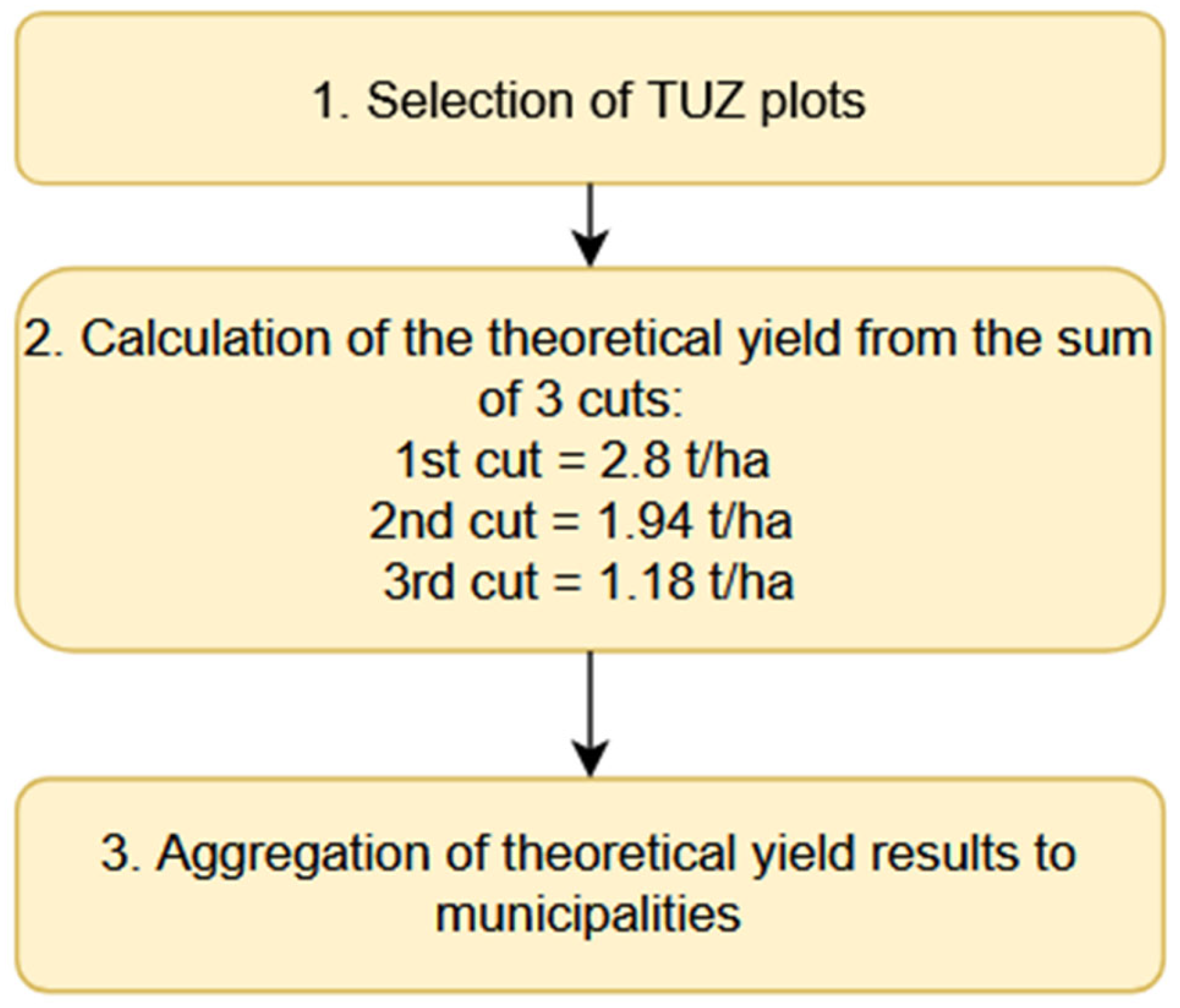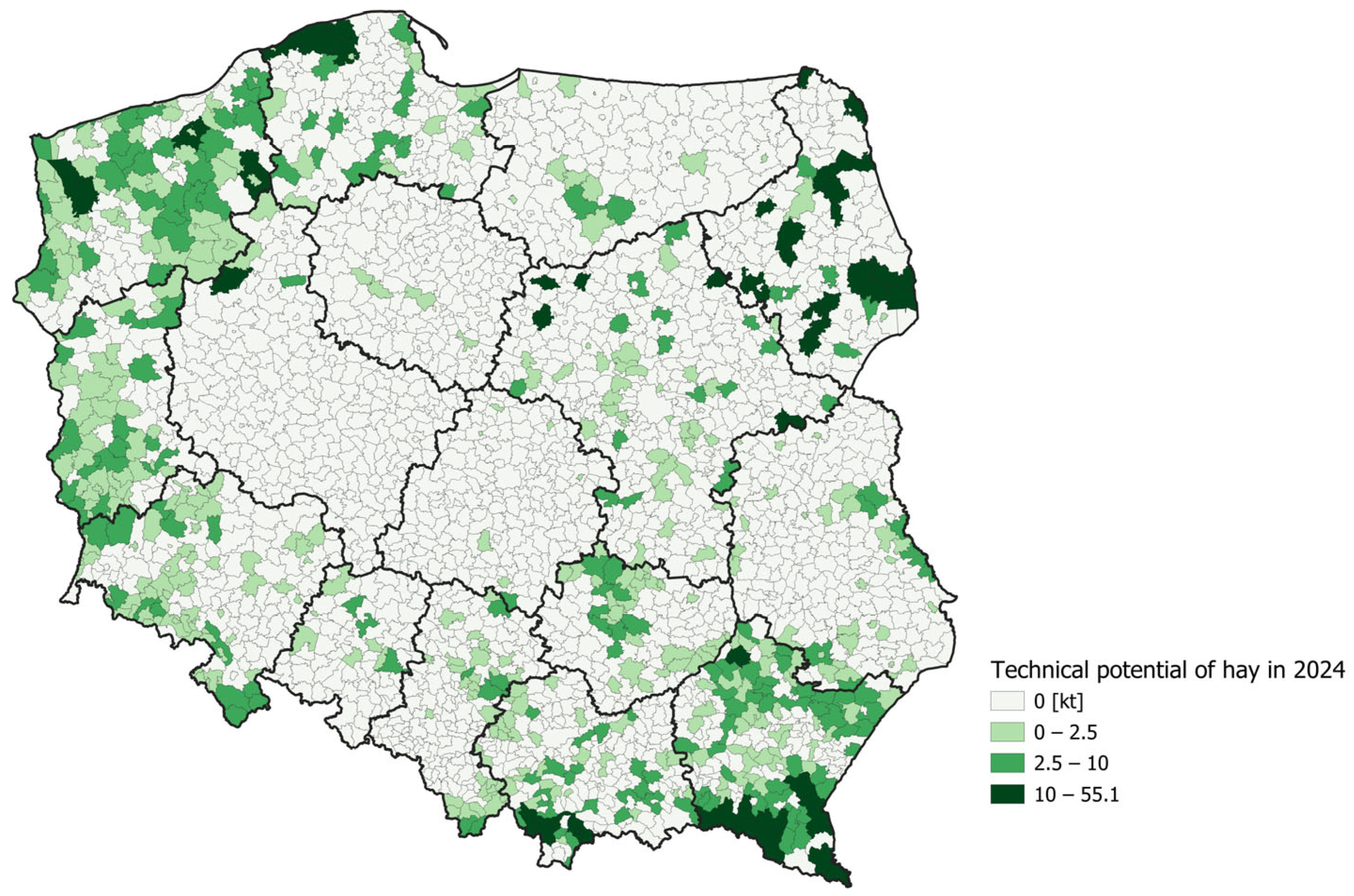Balancing Feed Demand and Energy Supply: Technical Potential of Permanent Grassland Biomass in Poland
Abstract
1. Introduction
2. Materials and Methods
2.1. Calculation of the Theoretical Potential of Hay
| Year | Total (t·ha−1) | 1st Cut (t·ha−1) | 2nd Cut (t·ha−1) | 3rd Cut (t·ha−1) |
|---|---|---|---|---|
| 2021 | 5.92 | 2.85 | 1.95 | 1.12 |
| 2022 | 5.98 | 2.81 | 1.96 | 1.21 |
| 2023 | 5.80 | 2.74 | 1.89 | 1.17 |
| 2024 | 5.95 | 2.79 | 1.95 | 1.21 |
2.2. Methodology for Calculating the Technical Potential of Hay
| Variant | Mowing Frequency | Unmown Area | Mowing Date | KBW Period |
|---|---|---|---|---|
| 1.1, 2.1, 4.1, 5.1 | 1 cut | 5–20% | 1 September–31 October | R13 |
| 1.2, 2.2, 4.2, 5.2 | Max. 2 cuts | 5–20% | 15 June–30 September | R7, R13 |
| 1.3, 2.3, 4.3, 5.3 | 1 cut | 5–20% | 1 August–31 October | R13 |
| 1.4, 2.4, 4.4, 5.4 | Max. 2 cuts | 5–20% | 15 June–30 September | R7, R13 |
| 1.5, 2.5, 4.5, 5.5 | Maks. 2 cuts | 5–20% | 15 June–30 September | R7, R13 |
| 1.6, 2.6, 4.6.1, 4.6.2, 5.6.1, 5.6.2 | 1 cut | Do 20% | 15 August–15 February | R13 |
| 1.7, 2.7, 4.8 | 2 cuts | 5–10% | 15 June–10 July 15 August–31 October | R7, R13 |
| 1.8, 2.8, 4.10 | 2 cuts | 5–10% | 1 July–31 July 15 August–31 October | R7, R13 |
| 1.9, 2.9, 4.9 | 1 cut | 5–85% | 15 August–15 February | R13 |
| 1.10, 2.10, 4.11 | 1 cut | 5–10% | 1 August–31 October | R13 |
| 3.1 | Max. 2 cuts | 5–20% | 15 June–30 September | R7, R13 |
2.3. Methodology for Calculating the Energy Potential of Permanent Grasslands
3. Results
3.1. The Theoretical Potential of Hay
3.2. The Technical Potential of Hay
3.3. Assessment of Energy Potential from Permanent Grasslands
4. Discussion
5. Conclusions
Funding
Data Availability Statement
Acknowledgments
Conflicts of Interest
Abbreviations
| TUZ | Permanent grasslands |
| ARiMR | Agency for Restructuring and Modernization of Agriculture |
| KBW | Climatic Water Balance |
| CAP | Common Agricultural Policy |
| OTOP | Polish Society for the Protection of Birds |
| o.d.m | Organic dry matter |
References
- GUS. Użytkowanie Gruntów z Wyszczególnieniem łąk i Pastwisk w 2023 r. Available online: https://stat.gov.pl/files/gfx/portalinformacyjny/pl/defaultaktualnosci/5507/5/6/1/charakretystyka_gospodarstw_rolnych_w_2023_r.pdf (accessed on 22 October 2025).
- Barczewski, J. Stan Trwałych Użytków Zielonych i ich Wykorzystanie w kraju. W: Racjonalne Wykorzystanie Potencjału pro-Dukcyjnego Trwałych Użytków Zielonych w Polsce w Różnych Warunkach Glebowych i Systemach Gospodarowania. 2015. Available online: https://www.itp.edu.pl/wydawnictwo/files/monogr_40_2015.pdf (accessed on 8 August 2025).
- Harasim, A.; Matyka, M. Regionalne zróżnicowanie trwałych użytków zielonych a wybrane wskaźniki rolnictwa w Polsce. Stud. i Rap. IUNB-PIB. Z. 2009, 15, 59–69. [Google Scholar]
- Wróbel, B.; Barczewski, J. Ocena gospodarowania na trwałych użytkach zielonych w różnych typach gospodarstw. Woda Sr. Obsz. Wiej. 2016, 16, 87–106. [Google Scholar]
- GUS. Produkcja Upraw Rolnych i Ogrodniczych w 2019 r. In Production of Agricultural and Horticultural Crops in 2019; Główny Urząd Statystyczny: Warszawa, Poland, 2019; pp. 31–39. [Google Scholar]
- Gabryszuk, M.; Barczewsk, J.; Wróbel, B. Characteristics of grasslands and their use in Poland. J. Water Land Dev. 2021, 51, 243–249. [Google Scholar] [CrossRef]
- Jankowska-Huflejt, H.; Okularczyk, G. Rola Trwałych Użytków Zielonych w Kształtowaniu Środowiska Przyrodniczego i Krajobrazu; IMUZ: Falenty, Poland, 2008. [Google Scholar]
- Burczyk, P.; Gamrat, R.; Gałczyńska, M.; Saran, E. Rola trwałych użytków zielonych w zapewnieniu stanu równowagi ekologicznej środowiska przyrodniczego. Woda Sr. Obsz. Wiejskie. 2018, 18, 21–37. [Google Scholar]
- Ministerstwo Klimatu i Środowiska. Sieć Natura 2000 w Polsce; MKiŚ: Warszawa, Poland, 2022. Available online: https://www.gov.pl/web/rdos-warszawa/obszary-natura-2000 (accessed on 22 October 2025).
- European Commission: Directorate-General for Communication. The European Green Deal–Delivering the EU’s 2030 Climate Targets; Publications Office of the European Union: Luxembourg, 2023; Available online: https://data.europa.eu/doi/10.2775/783179 (accessed on 22 October 2025).
- European Commission. The New Common Agricultural Policy: 2023–2027; Publications Office of the European Union: Luxembourg, 2021. [Google Scholar]
- Batáry, P.; Dicks, L.V.; Kleijn, D.; William, J.S. The Role of Agri-Environment Schemes in Conservation and Environmental Management. Conserv. Biol. 2015, 29, 1006–1016. [Google Scholar] [CrossRef] [PubMed]
- Kopeć, S.; Kukuła, K. Trwałe użytki zielone w aspekcie środowiskowym i gospodarczym w Polsce. Woda Sr. Obsz. Wiej. 2017, 17, 23–34. [Google Scholar]
- Ministry of Agriculture and Rural Development [MRiRW]. Plan Strategiczny dla Wspólnej Polityki Rolnej 2023–2027; MRiRW: Warsaw, Poland, 2022. [Google Scholar]
- Mikołajczak, J.; Wróbel, B.; Jurkowski, A. Możliwości i bariery w produkcji biogazu z biomasy trwałych użytków zielonych w Polsce. Woda Sr. Obsz. Wiejskie. 2009, 9, 139–155. [Google Scholar]
- OTOP. Ochrona Wodniczki w Polsce Wschodniej. Layman’s Report LIFE „Wodniczka i Biomasa. Ogólnopolskie Towarzystwo Ochrony Ptaków. 2014. Available online: https://www.otop.org.pl/uploads/media/layman_small.pdf (accessed on 22 October 2025).
- Goliński, P.; Daszkiewicz, J. Łąki Źródłem Biomasy? Chyba Warto Spróbować… Magazyn Biomasa, 13 Października 2014. 2014. Available online: https://magazynbiomasa.pl/laki-zrodlem-biomasy-chyba-warto-sprobowac/ (accessed on 28 August 2025).
- Ministerstwo Rolnictwa i Rozwoju Wsi. Interwencja Rolnictwo Ekologiczne PS WPR 2023–2027. 2025. Available online: https://www.gov.pl/web/rolnictwo/materialy (accessed on 22 October 2025).
- Instytut Technologiczno-Przyrodniczy—PIB. Ochrona Przyrody Obszarów Wiejskich; ITP-PIB: Falenty, Poland, 2024. [Google Scholar]
- Łabędzki, L.; Bąk, B. Standaryzowany Klimatyczny Bilans Wodny jako wskaźnik suszy. Acta Agrophysica 2004, 3, 117–124. [Google Scholar]
- Doroszewski, A.; Wróblewska, E.; Pudełko, R.; Żyłowska, K.; Koza, P.; Nieróbca, A. Krajowy System Monitoringu Suszy Rolniczej Jego Podstawy Metodyczne i Możliwości Wykorzystania. W: Innowacyjne Metody Gospodarowania Zasobami Wody w Rolnictwie; Dembka, W., Kusia, J., Wiatkowskiego, M., Żurka, G., Eds.; CDR Brwinów: Brwinów, Poland, 2016; pp. 105–128. ISBN 978-83-88082-18-4. (s. 296). [Google Scholar]
- Pudelko, R. 2013 Ocena Potencjałów Biomasy Ubocznej i Odpadowej w EU-27 i Szwajcarii Oraz Ich Regionalizacja. Monografie i Rozprawy Naukowe 39. Available online: https://iung.pl/images/pdf/habilitacje/Pudelko-hab.pdf (accessed on 22 October 2025).
- Winnicki, S.; Jugowar, J.L.; Nawrocki, L. Analiza możliwości organizacji bazy paszowej na glebach o niskiej bonitacji dla stada krów o wysokiej wydajności. Woda Sr. Obsz. Wiej. 2012, 12, 239–248. [Google Scholar]
- Curkowski, A.; Oniszek-Popławska, A. Surowce do produkcji biogazu—Uproszczona metoda obliczenia wydajności biogazowni rolniczej. Czysta Energ. 2010, 1, 25–27. [Google Scholar]
- Kopeć, B.; Goliński, P. Productivity and utilization of permanent grasslands in Poland. Grassl. Sci. Eur. 2010, 15, 403–405. [Google Scholar]
- Scarlat, N.; Fahl, F.; Lugato, E.; Monforti, F.; Dallemand, J.F. Integrated and spatially explicit assessment of sustainable crop residues potential in Europe. Renew. Sustain. Energy Rev. 2019, 100, 127–142. [Google Scholar] [CrossRef]
- Krasowicz, S. Regionalne zróżnicowanie uwarunkowań konkurencyjności polskiego rolnictwa. Stud. I Rap. IUNG-PIB 2019, 59, 93–108. [Google Scholar]
- Stolarski, M.J.; Krzyżaniak, M.; Tworkowski, J. Biomass for energy in Poland—Current status and future prospects. Renew. Sustain. Energy Rev. 2013, 22, 407–415. [Google Scholar] [CrossRef]
- Oleszek, M.; Matyka, M.; Bielińska, E.J. Utilization of marginal grasslands for renewable energy in Poland. Renew. Sustain. Energy Rev. 2012, 16, 408–414. [Google Scholar] [CrossRef]
- Dubas, J.W.; Zastawny, J.; Merta, M. Regional differences in grassland management and biomass potential for energy purposes in Poland. Probl. Agric. Eng. 2016, 92, 45–57. [Google Scholar]
- Kowalczyk-Juśko, A. Biogas production from grass biomass in Poland: Opportunities and limitations. In Renewable Energy Sources: Engineering, Technology, Innovation; Springer: Berlin/Heidelberg, Germany, 2010; pp. 329–336. [Google Scholar]
- Scarlat, N.; Dallemand, J.F.; Monforti-Ferrario, F.; Banja, M. The role of biomass and bioenergy in the EU energy transition. Biomass Bioenergy 2018, 120, 3–16. [Google Scholar] [CrossRef]
- Pawlak, J.; Mazurkiewicz, J.; Kowalczyk-Juśko, A. Potential of grassland biomass for biogas production in Poland. J. Water Land Dev. 2017, 35, 179–185. [Google Scholar] [CrossRef]
- Tonn, B.; Elbakidze, M.; Angelstam, P.; Axelsson, R. Multifunctional benefits of European grasslands: A systematic review. Ecosyst. Serv. 2020, 45, 101160. [Google Scholar] [CrossRef]





| Voivodeship | Livestock (LU) | Ratio LU/TUZ | Hay Allocated to LU (SK) [kt] |
|---|---|---|---|
| Dolnośląskie | 95,052.8 | 0.82 | 832.7 |
| Kujawsko-Pomorskie | 376,896.9 | 5.15 | 3301.6 |
| Lubelskie | 277,925.7 | 1.58 | 2434.6 |
| Lubuskie | 81,158.9 | 0.75 | 711.0 |
| Łódzkie | 337,184.9 | 3.01 | 2953.7 |
| Małopolskie | 142,297.5 | 1.03 | 1246.5 |
| Mazowieckie | 947,069.9 | 2.62 | 8296.3 |
| Opolskie | 107,418.7 | 3.26 | 941.0 |
| Podkarpackie | 85,579.7 | 0.55 | 749.7 |
| Podlaskie | 798,395.3 | 2.33 | 6993.9 |
| Pomorskie | 185,507.1 | 1.70 | 1625.0 |
| Śląskie | 113,148.5 | 1.93 | 991.2 |
| Świętokrzyskie | 108,433.3 | 1.24 | 949.9 |
| Warmińsko-Mazurskie | 363,500.1 | 1.29 | 3184.3 |
| Wielkopolskie | 891,662.3 | 4.76 | 7811.0 |
| Zachodniopomorskie | 96,085.6 | 0.54 | 841.7 |
| Total | 5,007,317.1 | 1.99 | 43,864.1 |
| Voivodeship | Dry Matter [kt] | Dry Organic Matter [kt] | Methane [kt o.d.m (at STP)] |
|---|---|---|---|
| Dolnośląskie | 0.0 | 0.0 | 0.0 |
| Kujawsko-pomorskie | 0.0 | 0.0 | 0.0 |
| Lubelskie | 0.0 | 0.0 | 0.0 |
| Lubuskie | 0.0 | 0.0 | 0.0 |
| Łódzkie | 0.0 | 0.0 | 0.0 |
| Małopolskie | 0.0 | 0.0 | 0.0 |
| Mazowieckie | 0.0 | 0.0 | 0.0 |
| Opolskie | 0.0 | 0.0 | 0.0 |
| Podkarpackie | 47.2 | 42.3 | 0.0127 |
| Podlaskie | 0.0 | 0.0 | 0.0 |
| Pomorskie | 0.0 | 0.0 | 0.0 |
| Śląskie | 0.0 | 0.0 | 0.0 |
| Świętokrzyskie | 0.0 | 0.0 | 0.0 |
| Warmińsko-mazurskie | 0.0 | 0.0 | 0.0 |
| Wielkopolskie | 0.0 | 0.0 | 0.0 |
| Zachodniopomorskie | 28.3 | 25.4 | 0.0076 |
Disclaimer/Publisher’s Note: The statements, opinions and data contained in all publications are solely those of the individual author(s) and contributor(s) and not of MDPI and/or the editor(s). MDPI and/or the editor(s) disclaim responsibility for any injury to people or property resulting from any ideas, methods, instructions or products referred to in the content. |
© 2025 by the author. Licensee MDPI, Basel, Switzerland. This article is an open access article distributed under the terms and conditions of the Creative Commons Attribution (CC BY) license (https://creativecommons.org/licenses/by/4.0/).
Share and Cite
Borzęcka, M. Balancing Feed Demand and Energy Supply: Technical Potential of Permanent Grassland Biomass in Poland. Crops 2025, 5, 79. https://doi.org/10.3390/crops5060079
Borzęcka M. Balancing Feed Demand and Energy Supply: Technical Potential of Permanent Grassland Biomass in Poland. Crops. 2025; 5(6):79. https://doi.org/10.3390/crops5060079
Chicago/Turabian StyleBorzęcka, Magdalena. 2025. "Balancing Feed Demand and Energy Supply: Technical Potential of Permanent Grassland Biomass in Poland" Crops 5, no. 6: 79. https://doi.org/10.3390/crops5060079
APA StyleBorzęcka, M. (2025). Balancing Feed Demand and Energy Supply: Technical Potential of Permanent Grassland Biomass in Poland. Crops, 5(6), 79. https://doi.org/10.3390/crops5060079







